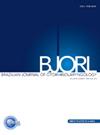黑草油对鼻中隔穿孔愈合的影响
IF 1.8
4区 医学
Q2 OTORHINOLARYNGOLOGY
引用次数: 0
摘要
鼻中隔穿孔(NSP)是一种具有挑战性的疾病,治疗方案有限,通常导致鼻塞和鼻出血等症状。黑草油(NSO)以其抗炎和再生特性而闻名,在促进伤口愈合方面表现出了希望。本研究旨在研究NSO对实验性NSP大鼠伤口愈合过程的影响,探讨其作为治疗NSP的药物的潜力。方法雄性sd大鼠22只,随机分为两组。每个受试者都有一个直径约2毫米的鼻中隔穿孔(NSP)。NSO(研究组)和生理盐水(对照组)局部应用,每天1次,连用14 d。第14天处死大鼠,切除鼻中隔进行肉眼和组织病理学检查。免疫组织化学检测血管内皮生长因子(VEGF)和增殖核细胞抗原(PCNA)参数。观察组织形态,测定胶原蛋白密度。统计分析nsp的宏观闭合率和组织病理学参数。结果与生理盐水组相比,snso组胶原密度、表面形态学评分、国际软骨修复学会(ICRS)基质检查评分、PCNA免疫反应性和nsp宏观闭合率均显著升高(p < 0.05)。VEGF免疫反应性两组比较差异无统计学意义(p > 0.05)。结论在实验性鼻中隔鼻炎模型中,局部应用NSO可促进鼻中隔伤口愈合,提示NSO可作为鼻中隔鼻炎的有效替代或辅助治疗方法,促进更好的临床疗效。证据等级:3级。本文章由计算机程序翻译,如有差异,请以英文原文为准。
The effect of nigella sativa oil on healing in nasal septum perforations
Objective
Nasal Septal Perforation (NSP) is a challenging condition with limited treatment options, often resulting in symptoms like nasal obstruction and epistaxis. Nigella Sativa Oil (NSO), known for its anti-inflammatory and regenerative properties, has shown promise in promoting wound healing. This study aims to investigate the effects of NSO on the wound healing process in an experimental NSP model using rats, exploring its potential as a therapeutic agent for NSP treatment.
Methods
Twenty-two male Sprague Dawley rats were randomly assigned to two groups. Each subject had a Nasal Septal Perforation (NSP) approximately 2 mm in diameter created. NSO (study group) and saline (control group) were applied topically once a day for 14 days. At the end of the 14th day, the rats were sacrificed, and their nasal septa were excised for macroscopic and histopathological examination. Immunohistochemically Vascular Endothelial Growth Factor (VEGF) and Proliferating Nuclear Cell Antigen (PCNA) parameters examined. Tissue morphology was evaluated, collagen density was measured. The macroscopic closure rate of the NSPs and the histopathological parameters were analyzed statistically.
Results
NSO group showed significantly higher collagen density, surface morphology score, International Cartilage Repair Society (ICRS) matrix examination score, PCNA immunoreactivity and macroscopic closure rate of NSPs compared to the saline group (p < 0.05). In terms of VEGF immunoreactivity, no difference was detected between both groups (p > 0.05).
Conclusion
Locally administered NSO may enhance wound healing in the nasal septum within an experimental NSP model, suggesting that NSO could be an effective alternative or adjunctive treatment for NSP, promoting better clinical outcomes.
Level of evidence
Level 3.
求助全文
通过发布文献求助,成功后即可免费获取论文全文。
去求助
来源期刊

Brazilian Journal of Otorhinolaryngology
OTORHINOLARYNGOLOGY-
CiteScore
3.00
自引率
0.00%
发文量
205
审稿时长
4-8 weeks
期刊介绍:
Brazilian Journal of Otorhinolaryngology publishes original contributions in otolaryngology and the associated areas (cranio-maxillo-facial surgery and phoniatrics). The aim of this journal is the national and international divulgation of the scientific production interesting to the otolaryngology, as well as the discussion, in editorials, of subjects of scientific, academic and professional relevance.
The Brazilian Journal of Otorhinolaryngology is born from the Revista Brasileira de Otorrinolaringologia, of which it is the English version, created and indexed by MEDLINE in 2005. It is the official scientific publication of the Brazilian Association of Otolaryngology and Cervicofacial Surgery. Its abbreviated title is Braz J Otorhinolaryngol., which should be used in bibliographies, footnotes and bibliographical references and strips.
 求助内容:
求助内容: 应助结果提醒方式:
应助结果提醒方式:


